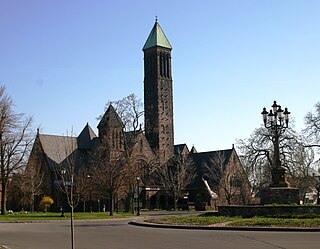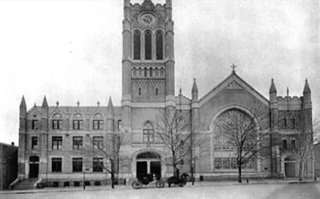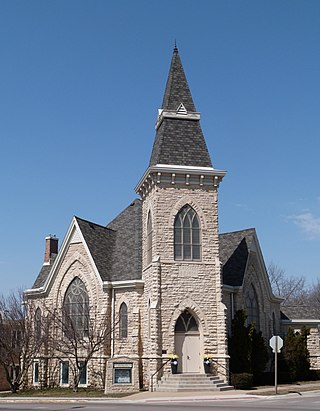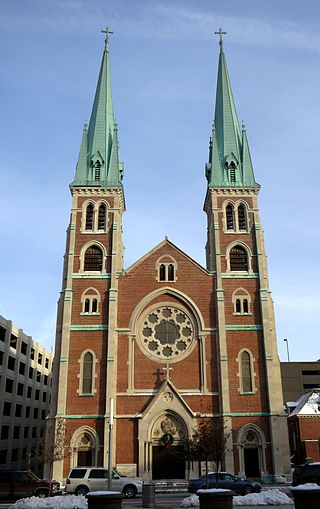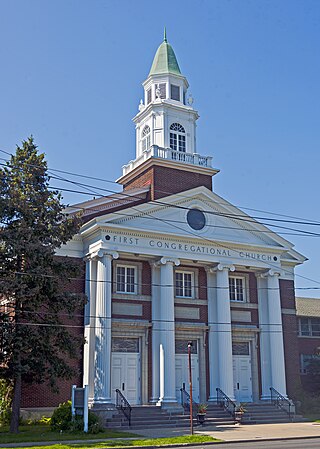The First Presbyterian Church has its origins in an August 1832 prayer meeting and Sunday-school held by Philo Carpenter in a carpentry shop, which was owned by Mark Beaubien at Fort Dearborn. Although there were changes in location, these services continued during the winter of 1832–33. Eventually, they were held at a cabin owned by "Father" Walker. At this location, Rev. Jeremiah Porter formally organized the church. On June 26, 1833, the church adopted the Covenant and Articles of Faith in the Presbytery of Detroit.
Charter members
Source: [6]
In Fort Dearborn Garrison| Name | Name | Name | Name |
|---|
| Capt. D. Wilcox | Richard Burtis | Sgt. J. Adams | Isaac Ingraham |
| Mrs. S.G. Wilcox | Benjamin Briscor | Mrs. H. Adams | William Johnson |
| Lt. L.T. Jameson | Ebenezer Ford | Sgt. William C. Cole | David Lake |
| Mrs. Ruth Ward | John Grey | Mrs. Julia Cole | James Murray |
The first public school in Chicago was organized in the meeting house of The First Presbyterian Church, and Porter's wife Eliza Chappell was the first teacher in this school. The membership of the church increased within a few months from 26 to 47, and to accommodate both soldiers and citizens, preaching services were held for a time both in the fort and at Father Walker's cabin on Wolf Point. On June 11, a committee was appointed to solicit subscriptions for the construction of a meeting house. Porter suggested that any money subscribed toward his support might be applied to the building fund. In the meantime, the American Home Mission Society made provisions for Porter.
The erection of the first house of worship was quite an event in the settlement. "Nearly all the inhabitants aided in the construction of this building, and the undertaking was so stupendous that every shoulder was needed at the wheel." The meetinghouse, built by Joseph Meeker, stood out in the open field without any fence around it, on what was later the alley of the lot at the southwest corner of Lake and Clark Streets, on the south 25 feet (7.6 m) of lot 1 in block 34 in the Original Town of Chicago. The Chicago Daily Democrat (1834) noted:
"The First Presbyterian Church has purchased lot 1 in block 34. The books of the Title Guarantee and Trust Co. do not, however, show any record of such a purchase. We can only infer that for the two years or more the Society was in possession of this lot it must have been by permission of the Trustees of the Illinois and Michigan Canal, who held title to the land."
The lot was purchased at the canal sale, June, 1836, more than two years after the meeting house was built, by James Curtiss, secretary of the Illinois Hotel Company. The hotel scheme collapsed in the panic of 1835–37, and thus the church was providentially permitted to continue in possession another year, until a new location was procured farther south on Clark Street, below Washington Street.
The new building was a plain frame structure, about 40 by 25 feet (12.2 m × 7.6 m), with plastered walls and bare puncheon floors. The cost was $600. The seating arrangements consisted of benches made of ordinary pine boards, which would accommodate about 200, including settlers and the troops from the garrison. In the spring months, when the water in the ditch in front of the church made it almost inaccessible, the benches taken from the church were the ordinary means for bridging the slough. Such was "Chicago's first built Protestant meeting house, commonly called 'the Lord's House,'and a useful building it was to the first settlers." It was dedicated January 4, 1834; Porter was assisted in the dedicatory services by Rev. A. B. Freeman, pastor of the First Baptist Church, who offered the consecration prayer.
From 1833 to 1835 the membership increased to about 100, and, as the church was then self-supporting, Porter felt justified in accepting a call to the Main Street Presbyterian Church of Peoria, Illinois, in the autumn of 1835.
During the two years which elapsed before a successor to Porter was secured, the pulpit was supplied partly by Rev. Isaac T. Hinton, pastor of the First Baptist Church, Rev. William McLean and Rev. J. J. Miter. Eventually, Rev. Dr. John Blatchford was called as the church's first installed pastor.
Aspirations to erect a cathedral, "to be built of marble," were dispelled by the financial depression of 1837. For a few years, the parishioners had to content themselves with their simple frame meeting house, although some desired changes were effected in its condition and location. The former situation had become undesirable, as the adjacent property was in demand for business purposes, and the people were going to the southern part of the city for their homes, "away out on the prairies below Van Buren Street." The building was moved in 1837–38 from its original position on Clark Street, near Lake Street, to the corner of Clark Street and the alley now known as Calhoun Place, south of Washington Street and facing Clark Street, being the south fifty feet of lot 1, in block 56, Original Town of Chicago. During the seven years following and prior to the purchase of the land by the Society, the owners did not demand any rental, as they "regarded the presence of the church a blessing to the whole community." After two years of unceasing labor, Rev. Dr. Blatchford's health gave way and he was obliged to terminate his work in Chicago. He was dismissed from the pastorate August 18, 1839, at his own request.
The nine years' ministry of Rev. Flavel Bascom, D.D., covered a period of remarkable growth in the membership and affairs of the church. The old frame meeting house was again enlarged by increasing its width, and, as the Society was now in a condition to have a home of its own, plans were under consideration for a permanent building.
May 7, 1844, the church purchased from Samuel and F. A. Russell, all of lot 1 in block 56, Original Town of Chicago, on the south end of which the "Wooden Church " was then standing. Though the trustees acquired a frontage of eighty feet on Washington Street and one hundred and eighty feet on Clark Street, the space was not sufficient to give proper light and ventilation for the building contemplated. An agreement was thereupon entered into with Robert Freeman, whereby title was acquired to the east twenty-seven feet of lot 2 in block 56, immediately west of and adjoining lot 1. The deed from Freeman to the church trustees was recorded December 19, 1849. This made a total frontage of one hundred and seven feet on Washington Street. The foundations of the "Brick Church" were laid in 1847, and in September, 1849, the building was dedicated.' In the meantime the finances of the Society were in such a condition that it became necessary for the trustees to sell a portion of the lot, according to an advertisement which appeared in the Daily Tribune of July 20, 1848.









